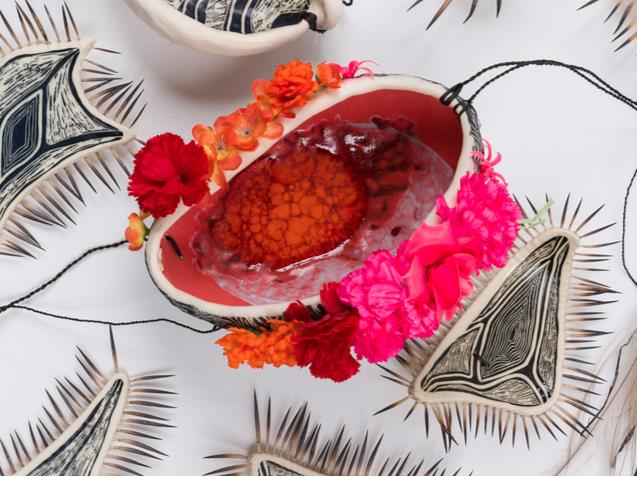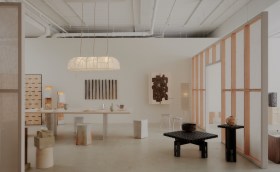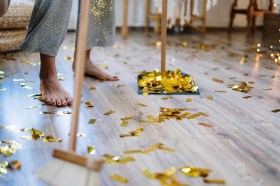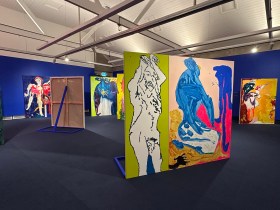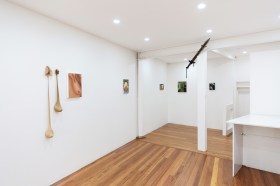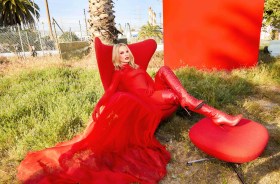Image: Penny Evans, Estuarine Creatures with Gawu 2018, white earthenware with sgraffito and glazes, echidna quills, emu feathers, plastic flowers, raffia. Gawu (egg) 21x18cm (diam), other dimensions variable. Photo: Penny Evans
The title of this exhibition, Measured Response says so much: a gentle pace; a thoughtful control, or pause; a bodily reaction, and a sense of considered scale.
As a viewer encountering this group show made by celebrated female Indigenous artists, one’s reaction is equally ‘measured’. This exhibition is an embrace of beauty; a seduction of the most subtle and simple, and encapsulates a sense of lightness, which is not always found in contemporary Aboriginal art.
Curated by Emily McDaniel, with the assistance of Lilly Lai, this exhibition commissioned by NAS Gallery (National Art School Darlinghurst), takes as its premise a reflection upon the ‘bodily and spiritual relationships between artists and the objects they make’.
Walking into the gallery it may not be immediately obvious – one first encounters the works of Gorawarl Jerrawongarla artist Julie Freeman, with her Grandmother Basket (2005) and Granddaughter Basket (2005). Freeman’s words printed on the gallery wall: ‘You carry everybody in yourself, you are everyone who’s ever been, and those memories never leave. You are the Grandmothers. It’s not me who’s using the hands. I’m just the instrument. I’m just the worker. They’re the designers.’
For her a basket is not a useful object but rather a conversation, to hold stories.
The exhibition quickly flows to the work of Delissa Walker, who also turns to matrilineal histories with her Ngadijina: Kakan (dilly bag) large (2017) and the story of being hidden inside these bags while children were taken from their families. Central to the room is an installation of weavings by members of the Hands on Weavers collective from Wagga Wagga (NSW), presented on a knee-high circular pedestal and speaking about all hands working as one. And then on vitrines are pots by the late Dr Thancoupie Gloria Fletcher AO, which the gallery describes as ‘physical manifestation of her gestures… In one bold motion she would pound (the clay) against her knee, her body the negative space that materialised the form.’
We start to get it – slowly and measured. The curator explains: ‘The body has always provided a point of reference and measurement. We measure lengths with an outstretched arm; we take large strides to record space in approximate metres. Our relationship to the world is gauged in proportion to our physical dimensions. The artists here engage with materiality by activating their bodily knowledge and in doing so, leave traces of themselves within the objects they create.’
In the next space the viewer encounters the work of Tamara Baillie – muslin cloth that has been coated in a sugar solution and dried. Floating against dark blue walls they are ethereal, fragile and incredibly beautiful.
Tamara Baillie Flow 2017-2018, cotton, sugar, single screen digital video, courtesy the artist, Adelaide
Flow (2017-18) is described as a mindful pause, a deep breath amidst the cerebral human experience and the repetition of breath as an anchor.
Each work is accompanied by a short text by the artist, which reaches out to the viewer in with its own bodily connection.
Moving to the upstairs gallery this exhibition really starts to breathe – to sing. My guess it is the height and light of this gallery that gives these works the space they need.
At one end of the gallery is Yhonnie Scarce’s installation Not Willing to Suffocate (2012), which records the artist’s breath in glass sculptures that are the form of bush bananas, representative of your people and country. It is a story of resistence and resilience against colonisation, using scientific equipment to point to the ethnographic studies conducted on Aboriginal people in the 1920s and 30s.
She says of glass: ‘You can drop it and it may not smash. For me, that’s the perfect metaphor for how strong Aboriginal people are too.’

Yhonnie Scarce Not Willing to Suffocate 2012, handblown glass and painted metal, courtesy the artist and Diane Tanzer | This Is No Fantasy, Melbourne
At the opposite end of the gallery is the work of Lucy Simpson inspired by a visit to Harvard University in Boston to view collections belonging to her Yuwaalaraay community and ancestors. Her work Winangaylanha ngay mara (2018) is a bodily response to this experience; the title means ‘my hands remember’.
Central is an incredibly powerful collection of sculptural pieces by Lorraine Connelly-Northey using bed spings, corrugated iron and wire to create narrbangs (string bags), digging sticks, possum skin cloaks and koolimans (bush bowls).

Image: Measured Response installation view work by Lorraine Connelly-Northey. Photo: Peter Morgan
And completing the upstairs works is Kamilaroi artist Penny Evans’ ceramic wall-based installation. The curator’s said of Evans’ work: ‘At times an object takes the form of a matrilineal ancestor, at others, it becomes a constellation, but it is through the making process that Penny better understands how she is connected to them.’
This is a beautiful show. This is a powerful show. It is an exhibition that undeniably connects through the most authentic and instincitive way – body language – and through it we are able to take a step closer to better understanding of the importance of narrative and bodily connections that these artists hold to their ancestory, their heritage, their culture and their country.
Rating: 4 ½ stars ★★★★☆
NAS Gallery, National Art School, Darlinghurst
30 May – 28 July 2018
Artists: Tamara Baillie Lorraine Connelly-Northey Euraba Artists and Papermakers Penny Evans Dr ancoupie Gloria Fletcher (anakupi) AO Julie Freeman Hands on Weavers Yhonnie Scarce Lucy Simpson Delissa Walker

